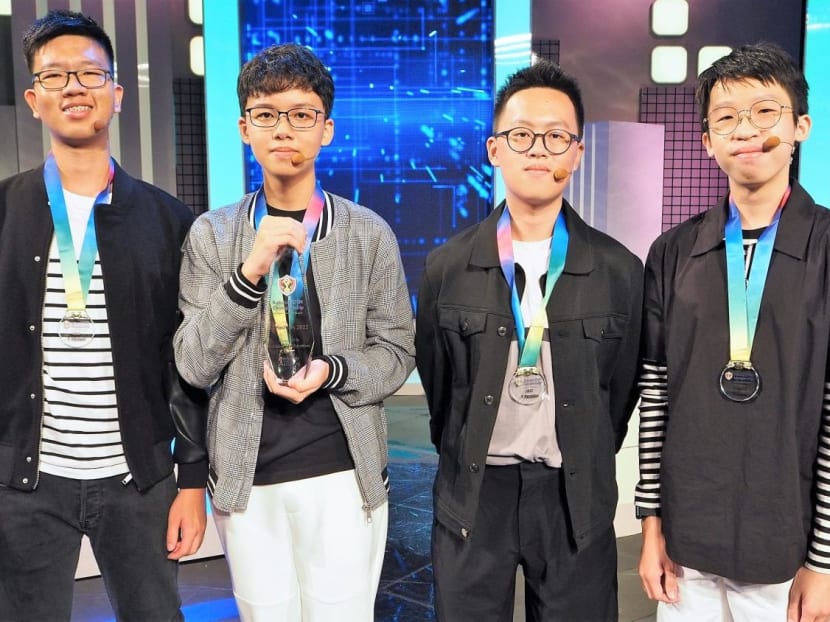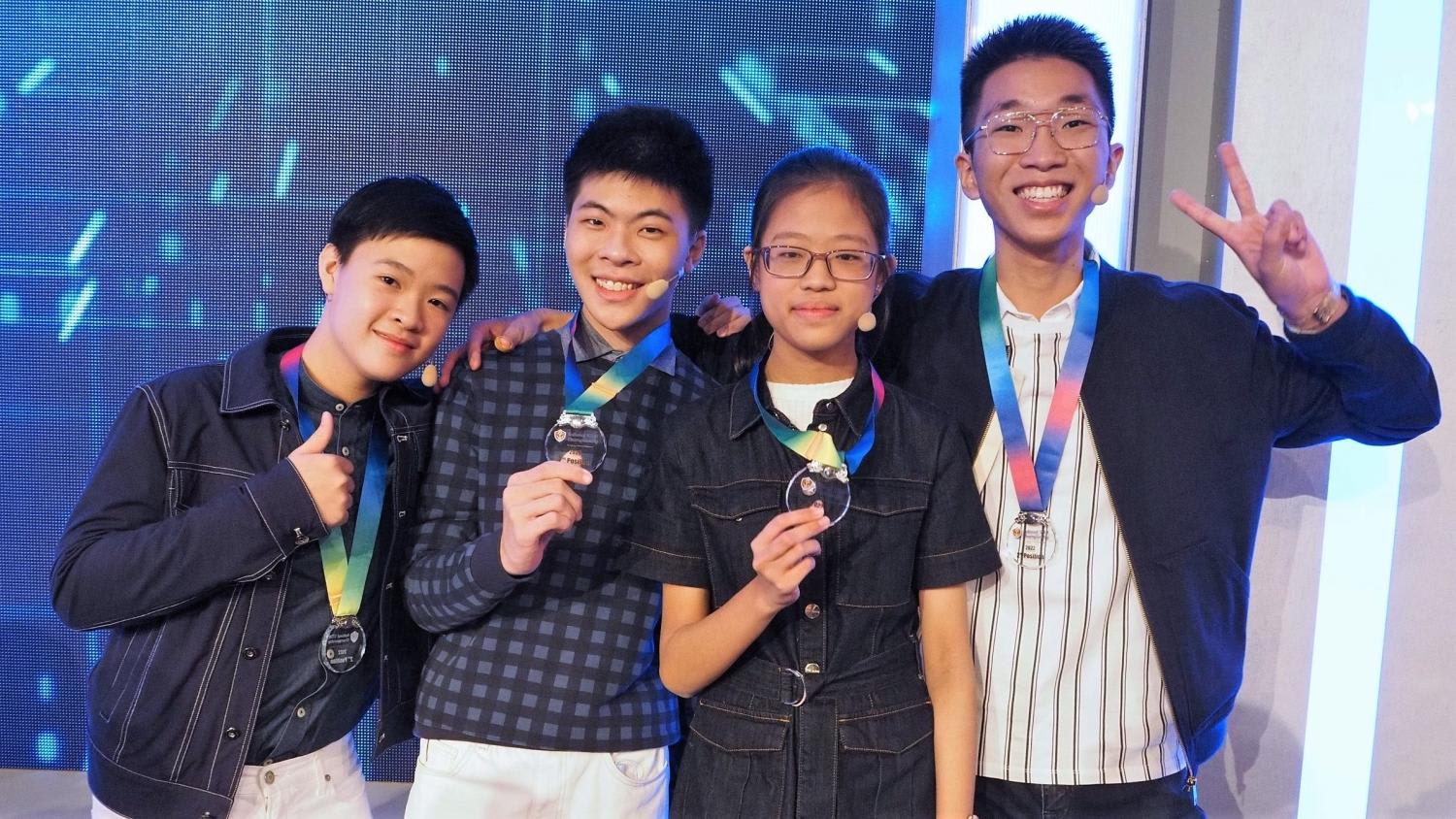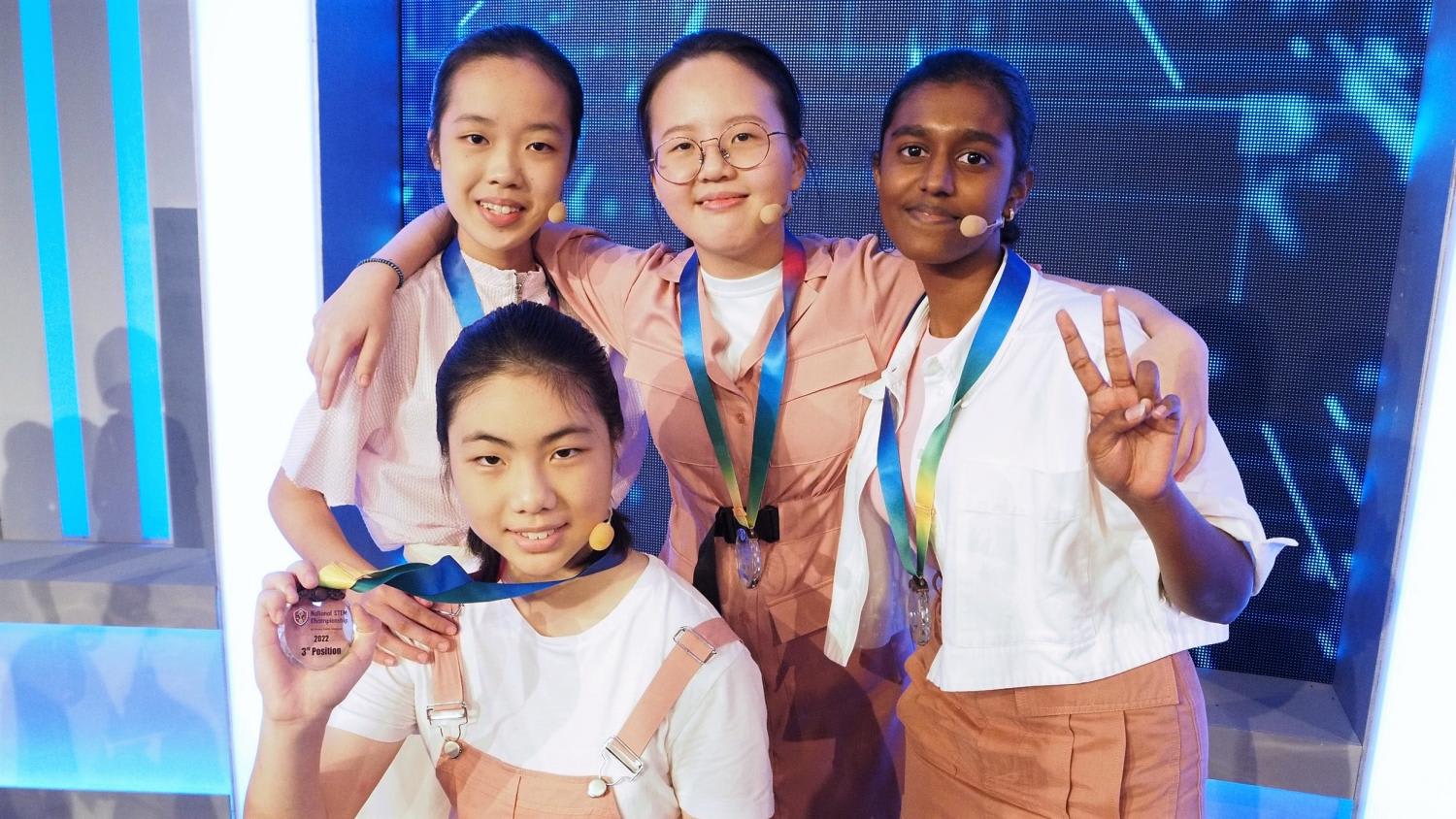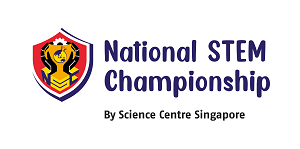Students take on real-world challenges in the National STEM Championship
Formerly known as the National Science Challenge, the National STEM Championship showcases the power of research, innovation and collaboration in everyday life.

The team from Raffles Institution were the grand winners of the National STEM Championship. From left: Jared Xu, Oliver Lim, Teo Kai Wen and Francis Loh. Photos: Mediacorp
Formerly known as the National Science Challenge, the National STEM Championship showcases the power of research, innovation and collaboration in everyday life.
One of the most exciting events in every science-oriented secondary student’s calendar, the competition that was formerly known as the National Science Challenge has morphed into the National STEM Championship (NSC).
The evolution of the annual student competition – organised by Science Centre Singapore –aligns it better with Singapore’s research, innovation and enterprise landscape. Besides science, the NSC now includes technology, engineering and mathematics topics, giving the audience and participants an opportunity to learn more about emerging technologies and STEM applications.
Dr Lee Song Choon, director KidsSTOP, Events & Engagements and Schools & Professional Development at Science Centre Singapore, explained that the competition has shifted from being centred on knowledge and rote memory work to incorporating technical and hands-on applications of STEM.
“We have also placed greater emphasis on elements such as teamwork, co-operation, resilience as well as science communication, all of which are essential skillsets for the STEM industry,” he added.
Through a series of hands-on challenges, teams were tasked to discover the scientific secrets of everyday objects and uncover how scientific innovations have changed lives.
“Participants now need to design and create structures. Previously, most of the work was theoretical,” explained judge Dr Massimiliano Colla, a senior lecturer at the Singapore University of Technology and Design. “The teams fared very well – they learned that problems can occur at a moment’s notice and may require innovation, creativity and ingenuity to be resolved.”
This year’s grand winner was the Raffles Institution (RI) team, with the first runner-up position going to NUS High School of Math & Science (NUS High). Raffles Girls’ School (RGS) was the second runner-up, while CHIJ St Nicholas Girls’ School (SNGS) took third runner-up.
COVERING FRESH GROUND

The broader scope of the NSC made for more uncertainty going into the competition, according to RI’s Francis Loh, 15. “But this made it all the more exciting, too,” he said.
“STEM provided so many more interesting elements and varieties of challenges, which made the competition much more fun,” agreed Kristen Yee, 15, from SNGS.
Besides studying up on STEM topics, all the teams made an effort to prepare for the different elements of the NSC. According to 15-year-old Glenda Lim of RGS, her team’s prior experience with hands-on experimentation and prototype-making provided them with a better foundation in the scientific process.
Still, there were some nervous moments as teams grappled to deal with the unexpected. RI’s Teo Kai Wen, 14, recounted how his team’s air-powered projectile only flew a few centimetres during the qualifying round: “It was shocking and disappointing as the projectile flew much further during testing.”
Ong Rui Ting, 15, from SNGS, found the qualifying challenge tough, due to the limited time and materials supplied: “It stretched us a lot in terms of our design and creativity.”
Judge Rosa So Qi Yue, head of the Healthcare and Medtech Division at the Institute for Infocomm Research, Agency for Science, Technology and Research (A*STAR), acknowledged that “it was a steep learning curve” for some teams, especially during the Onsite Challenge – a key component of the NSC that saw teams visit STEM organisations.
AN INTERDISCIPLINARY SHOWCASE

The challenges in the NSC all required an interdisciplinary approach, according to judge Hortense Le Ferrand of Nanyang Technological University: “For example, the bridge challenge incorporated physics, materials science and design.”
“The NSC’s interdisciplinary nature and hands-on elements made the competition much more unpredictable and challenging, but also really fun,” said Jisoo Kim, 15, of RGS.
Agreed Yvonne Aurelia Wibowo, 15, of SNGS: “The most interesting moment was the quarter finals, as we experienced the widest variety of challenges such as building a bridge and learning about genetic diseases.”
In one of the semi-finals, teams participated in an onsite challenge at Rolls-Royce, where they were asked to programme and design an autonomous car prototype that could manoeuvre around a racetrack.
“This required coding and engineering knowledge, like knowing where to place the sensors. It resembled real-life interdisciplinary applications,” explained judge Dr Ang Shi Jun, a scientist at the Institute of High Performance Computing, A*STAR.
“I felt the engineering challenge in the semi-finals was the toughest, but I’m so glad we managed to push through,” said David Chik, 16, from NUS High. “The feeling was absolutely phenomenal.”
While the teams worked hard, they had time to marvel at cutting-edge innovations. The tour of the Advanced Remanufacturing and Technology Centre – a venue where teams had to work on an automated vaccine dosage system – fascinated Solomon Lim, 15, from NUS High, who called it “the most fun moment of the championship”.
Teams also needed to collaborate and communicate well to complete challenges and convey information to the audience. The celebrity presentation segment of the grand finals was a test of teams’ ability to create a presentation with the provided materials.
Said judge Ooi Yau Yen, Engineering (Innovation) chief at the Advanced Remanufacturing and Technology Centre: “I liked the way the solutions were presented in the form of a storyline, because it humanised the solution in a way that’s easy for the layman to understand.”
STEM FOR THE FUTURE
The NSC experience has given participants a new perspective on STEM. Said Eyu Kai Xing, 15, of SNGS: “ I now truly understand the capability of STEM. I’m most excited about emerging technologies like artificial intelligence and genetic engineering.”
“The competition has allowed me to better appreciate the beauty of STEM, and made me more passionate about it,” agreed NUS High’s Chua Ke Rui, 15.
Her teammate Zhu Yancun, 16, appreciated the chance to bond with other contestants. “One thing I am very grateful for is the networking with like-minded youths in Singapore.”
Similarly, RGS’ Abhineshwari Narayanan, 15, enjoyed meeting new people. “Every moment was a new experience for me, and every moment of the championship was fun as we broadened our horizons.”
Others were inspired by their NSC experience to aim for careers in STEM. “I hope I’ll be able to use my knowledge of STEM to really embrace the interdisciplinary, interconnected future,” said Jared Xu, 15, of RI. “Hopefully, I’ll be able to make the world a better place with new innovations or findings.”
Catch the National STEM Championship 2022 on meWATCH.








